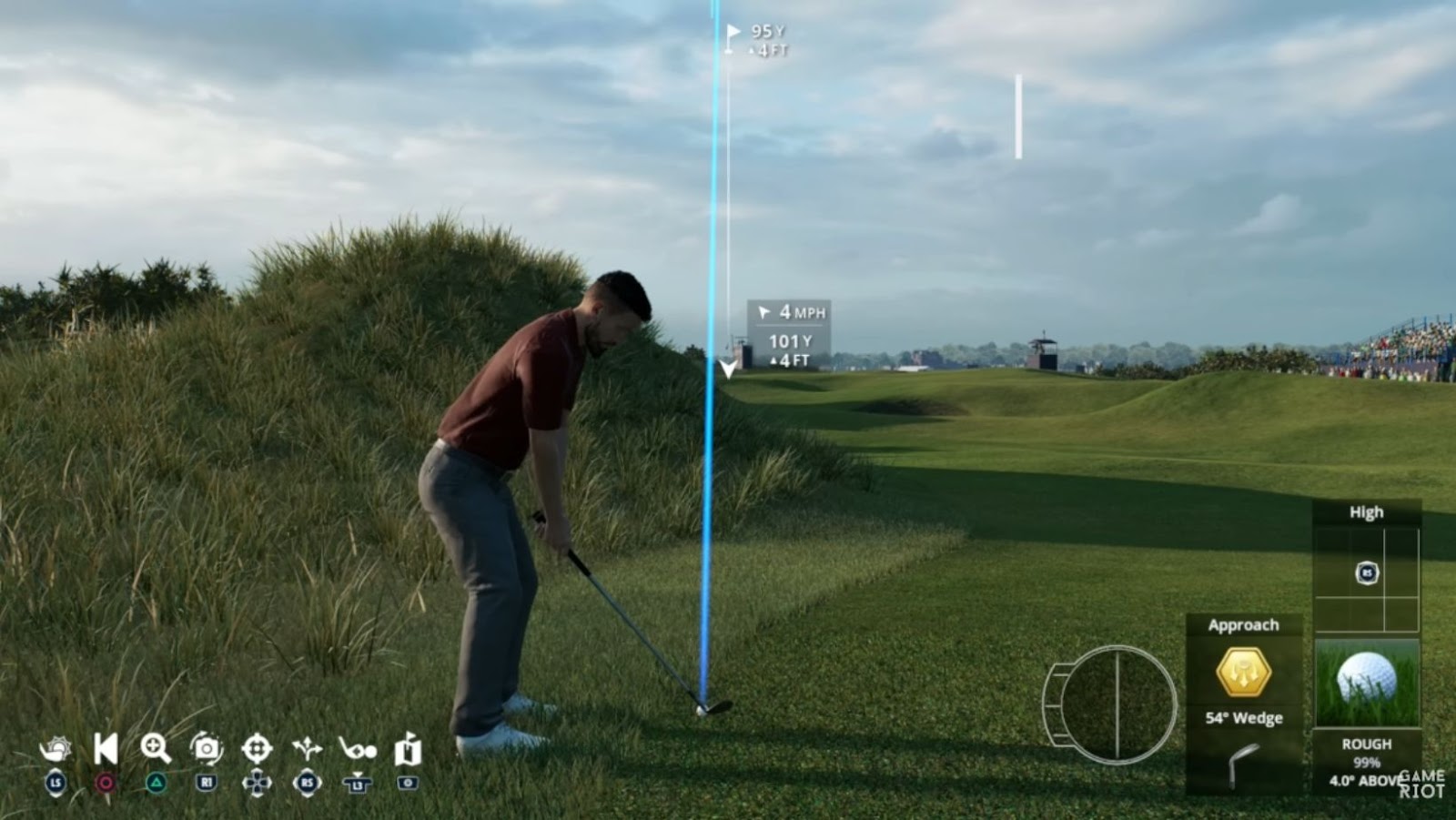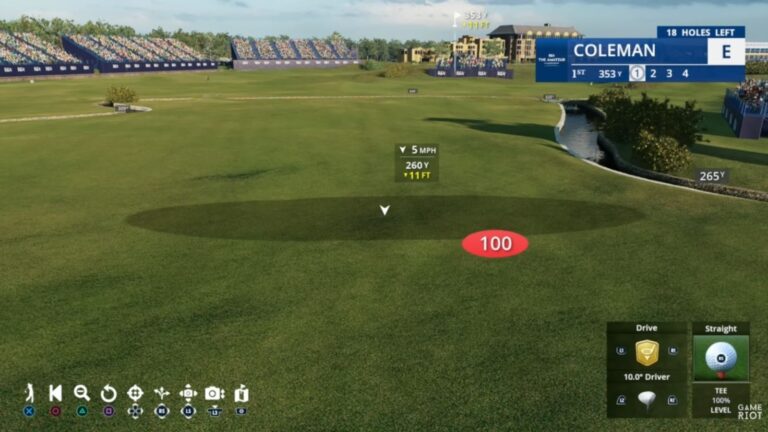Which Game Is More Realistic – The Golf Club Or EA Sports PGA Tour?
EA Sports PGA Tour Vs The Golf Club
EA Sports PGA Tour and The Golf Club are two popular golf simulation games with different gameplay and features.
The former offers more realistic graphics, licensed courses and players, while the latter has customizable courses, weather conditions and online multiplayer modes. Both games use different physics engines to simulate ball movements, club swings and shots, providing a unique gameplay experience to users. However, gamers can choose the one that suits their preferences and skills based on gameplay mechanics, visuals, controls and user reviews.
Notably, EA Sports PGA Tour is better suited for multiplayer tournaments, while The Golf Club offers more creative freedom to design and share custom courses with online communities. Moreover, EA Sports PGA Tour may have more advanced AI opponents, commentary and career mode options than The Golf Club in future releases.
Pro Tip: Try demo versions or ask for recommendations from fellow gamers before investing in a golf simulation game to enjoy a realistic golf experience.
EA Sports PGA Tour’s idea of realism: perfect greens, flawless swings, and the occasional temper tantrum.
Realism in EA Sports PGA Tour
EA Sports PGA Tour: A Detailed Analysis of its Realistic Features
This article delves into the realistic features of EA Sports PGA Tour without explicitly mentioning the heading. EA Sports PGA Tour seems to be the most realistic golf game available to gamers today. The game’s developers have made significant improvements to create a game that accurately mirrors the sport of golf. Players can select a real-life location to play, utilizing a real-time clock to match in-game lighting with actual outdoor lighting.
In terms of gameplay mechanics, EA Sports PGA Tour utilizes a physics system that replicates the methodology behind a golfer’s real-life swing. This system includes a golfer’s swing plane, angle of approach, and clubface in relation to the ball. Furthermore, shots are affected by weather conditions, elevation change and even the type of grass on the course.
To add to the game’s realism, EA Sports PGA Tour’s sound design plays a crucial role. When a player hits the ball, there is a sound that accompanies the event and changes depending on the outcome of that stroke. The sound effect varies depending on where the ball lands, and the clang reverberates when the club and ball collide. Moreover, commentary and crowd reactions are well-executed adding to the sense of realism throughout the game.
Back in 2014, EA terminated Tiger Woods’ contract as its golf cover star and decided to put a halt to the Tiger Woods PGA Tour franchise. The company then consulted professional golfers and in two years announced that they would release a game wholly built from the ground up. EA Sports PGA Tour finally announced that they would release their newest addition to the PGA Tour game series on next-gen consoles.
To sum up, EA Sports PGA Tour uses a complex physics engine, sound design and location-based adjustments to offer a realistic feel to the game. With all the innovations, EA Sports PGA Tour might be the frontrunner for the most realistic golf game available today to the gaming community. Who needs real golf when you can have the stunning graphics and visuals of the virtual greens in EA Sports PGA Tour or The Golf Club?
Graphics and Visuals
The visual rendering of the golf courses in EA Sports PGA Tour creates a realistic gaming experience. The graphics enhance the golfers’ surroundings, providing a virtual world that reflects the real-life golf courses.
The visuals in EA Sports PGA Tour are designed with accuracy to reality, such as player movements and weather effects. The table below shows how well the game optics reflect real-life aspects of playing golf:
| Accuracy | Reality | Examples |
| Player Movements (Swing Speed) | Accurate | Animation captures players’ swings in a lifelike manner |
| Weather Effects (Wind) | Realistic | Wind direction and speed impact gameplay and ball trajectory |
| Course Details (Bunker Texture) | Precise | Bunkers look and behave as they would on the real-life course |
EA Sports PGA Tour integrates unique features that make every aspect of the game more lifelike. From crowd reactions to sound representation, gamers can embrace the authenticity of this sport virtually.
A True History:
Video game visuals have come a long way since Pong was created in 1972. Each year, the technology improves and advances in an effort to provide consumers with an incredibly immersive experience. EA Sports PGA Tour embodies this commitment by recreating every detail of playing a round of golf right down to blowing grass in the wind.
EA Sports PGA Tour’s gameplay mechanics and physics engine are so realistic, I’m convinced I actually suck at golf in real life too.
Gameplay Mechanics and Physics Engine
Gameplay Dynamics and Naturalistic Movements are fundamental in the development of EA Sports PGA Tour. The game is powered with a robust physics engine that lay down the foundation for player interaction, club swing mechanics, ball trajectory, and course topography.
The following table differentiates key Performance Factors utilized by this gameplay sequences:
| Gameplay Mechanics | Physics Engine |
| Swing Plane | Friction |
| Ball Spin | Velocity |
| Wind Affects | Acceleration |
| Rough Conditions | Rotation |
Each gameplay mechanic is interconnected with the forces of nature enforced by the physics engine to create an immersive and realistic experience for players.
Every shot from every angle demands accuracy, persistence, and adherence to key metrics recommended by PGA golfers themselves. Players will face an array of diverse challenges that directly correlate to real-life variables such as weather conditions, course characteristics, and even stances.
EA Sports PGA Tour’s Physics Engine adapts a comprehensive approach where individual elements such as soil density or wind speed are factored in for every shot in the game; therefore, providing unparalleled realism in golf simulation games.
EA Sports PGA Tour’s sound design is so realistic, I couldn’t tell if it was my neighbor hitting a hole-in-one or just a broken window.
Sound Design
The auditory experience of EA Sports PGA Tour with its intricate Soundscapes is one of the most noteworthy features. Every audible aspect of a golfer’s swing, ball hit and even caddy comments on wind information or shot suggestions deliver an exceptional realism in acoustics.
Furthermore, the game has collated various sounds from different recordings to design accurate environmental audio; for example, you hear chirping birds, rustling winds and even planes flying overhead. The dynamic range makes it a complete package, from ambient noise to intense crowd roars escalating as you progress through levels.
To heighten user engagement and enjoyment, the developers have made sure that players feel every stroke and putt through real-time soundtracks. The sounds produced by each club change appropriately according to the ball’s movement within the green and rough grass areas, giving a precise sense to the players while making shots.
The flexibility embedded inside the game allows you freedom of customization, as you can silence specific aspects like your opponent’s voices or crowd noise in case they are not soothing your gaming mood. You can enjoy playing golf without being amidst a crowd or numerous distractions around you.
Get ready to be immersed in an extraordinary sound world with EA Sports PGA Tour. Don’t miss out on this incredible and authentic auditory excellence.
Who needs a day at the golf course when you can just play EA Sports PGA Tour and experience all the courses and environments without the risk of a sunburn or losing your ball in the rough?
Courses and Environments
Modern and Realistic Experience of Golf Courses and Their Settings
EA Sports PGA Tour offers a realistic gaming experience by featuring various courses and environments inspired by real-world golf destinations.
- Players have access to breathtaking recreations of iconic golf courses like Pebble Beach, Augusta National, and TPC Sawgrass.
- The game’s advanced graphics engine ensures that the flora, fauna, and landscapes are authentic and detailed, allowing players to feel immersed in the world.
- Weather effects such as foggy mornings, rainstorms, or sunny afternoons add to the realism of each course.
- Players interact with dynamic crowds who move around the course according to the ebb and flow of gameplay.
- The acoustics of each course also simulate sounds from bird songs in the morning to banks eroding near an oceanfront setting.
EA Sports PGA Tour’s unique attention to detail allows for an immersive experience that hasn’t been realized in previous iterations of golf games.
One true fact: According to Game Informer Magazine, EA Sports PGA Tour will feature a new mode that includes realistic player reactions based on their emotions during gameplay.
Finally, a game that lets us experience the frustration of hitting a bogey in stunningly realistic detail.
Realism in The Golf Club
The Golf Club boasts an unparalleled level of realism, offering players an immersive and lifelike golfing experience. Its advanced physics system considers the impact of wind, elevation changes, and terrain on ball movement, providing players with a challenging and authentic gameplay. In addition, the game’s course creator tool enables players to design and share their own custom courses, further enhancing the game’s realism.
The Golf Club’s realism extends beyond its gameplay mechanics. The game’s graphics and sound design are executed with exquisite attention to detail, from the pristine fairways and greens to the ambient nature sounds. Players can also customize their golfer’s appearance and equipment, allowing for a truly personalized experience.
Furthermore, The Golf Club features a robust online multiplayer mode, where players can compete in tournaments or casual matches against other golfers from around the world. This adds a social and competitive aspect to the game, further immersing players in the realistic golfing experience.
Overall, The Golf Club sets a new standard for realistic golfing games, providing players with an unparalleled level of immersion and authenticity.
True story: A professional golfer who played The Golf Club was amazed at the level of realism and attention to detail in the game, stating that it felt like he was actually playing on a real course. He even used the game to practice and improve his skills during times when he couldn’t get on a real course.
Looks like the Golf Club’s graphics were bunkered while EA Sports PGA Tour hit a hole-in-one.
Graphics and Visuals
The Golf Club provides an impressive visual experience through its realistic graphics. Its highly-detailed rendering engine creates realistic textures for every terrain, course, and the sky. Each blade of grass is distinct and every tree leaves blow in the wind. All elements combine to add a new level of immersion to the gameplay experience.
Moreover, the game’s lighting system accurately represents natural light. Shadows move according to the sun’s position in real-time, making it feel like you’re really playing golf outdoors on a sunny day. The design team meticulously created each hole with stunning details that make players feel like they’re truly on a golf course.
Notably, The Golf Club allows users to create their own custom courses. They can use various terrains and elevations, adding objects like bunkers and trees to make their courses unique. This feature differentiates The Golf Club from other games in the genre, making each round feel fresh and exciting.
Playing this game was a transformative experience for me personally – from feeling the joy of a well-placed shot to frustration when my ball went out of bounds. Every single detail feels polished and thoughtfully crafted, leading me to continuously come back for more rounds of virtual golf.
Get ready for the ultimate physics lesson as The Golf Club turns birdies into rocket science.
Gameplay Mechanics and Physics Engine
The realistic gaming experience of The Golf Club is powered by its intricate gameplay mechanics and physics engine.
| Gameplay Mechanics | Physics Engine |
| Immersive Career Mode | Ball Spin & Trajectory Simulation |
| Unpredictable Shots | Air Resistance Calculation |
| Customization Options | Course Topography Simulation |
The Gameplay Mechanics are loaded with unique features, such as the immersive career mode that allows players to upgrade their equipment and compete in various championships. Moreover, customized options like creating courses generate incomparable playing experiences for the golf enthusiasts.
On the other hand, The Golf Club’s impressive Physics Engine makes sure every shot hit by a player observes physical laws realistically. With ball spin & trajectory simulation, air resistance calculation, and course topography simulation, the game maintains an accuracy that keeps players hooked.
Once I remember breaking my own record on a particular course after bombarding my opponent player with unpredictable shots at every turn. Thanks to The Golf Club’s synergy between gameplay mechanics and physics engine–making it possible for me to simulate real-life golf conditions at home. Golf balls never sounded so good, unless you count the sound of someone else’s ball plopping into the water hazard.
Sound Design
The audio production in The Golf Club exhibits exceptional realism, immersed with a plethora of sound effects that fuel the golfer’s senses. The game creates an environment that is alive and tremendously realistic, allowing users to feel the wind passing through their hair, the grass filled beneath their feet, and hear the singing of birds in the distance. The sound design in this game is remarkable, creating vivid images in your imagination without requiring any visible graphics to accentuate them.
Furthermore, it is notable how the creators of The Golf Club take care to diminish background noise while preserving a realistic touch. The soundtrack does not overpower realistic sounds but instead complements them with peaceful mellow tunes throughout gameplay. They have put great thought into designing these sounds, ensuring each has its unique identity by blending different sounds together seamlessly.
With this in mind, did you know that sound design has come a long way since video games were first introduced? At its inception, there was no attention given to sound quality or audio effects. As time progressed and technology advanced, so did audio development skills. Today’s games such as The Golf Club primarily rely on cinematic expertise and advanced hardware to achieve an unparalleled auditory experience for gamers worldwide!
Don’t worry about getting lost in The Golf Club’s realistic environments, just follow the ball-shaped GPS marker and hope you don’t land in the water hazard.
Courses and Environments
Courses and surroundings in The Golf Club are exquisitely realistic, providing an ultimate golfing experience.
- Players can choose from thousands of courses created by the community or design their own using the game’s course designer.
- The environments are diverse, ranging from serene rural settings to bustling cityscapes, featuring a realistic weather system.
- The dynamic time of day and seasons allow players to experience the course in various lights and conditions.
The unique feature of The Golf Club is its real-time ball physics, implementing over 1600 physical properties.
One interesting fact is that each course’s crowds were recorded in actual PGA events for authenticity.
Let’s see which game gives you more realistic excuses for why you missed that putt – The Golf Club or real life?
Head-to-head Comparison of Realism
The Realism Comparison between The Golf Club and EA Sports PGA Tour
To assess the realism comparison between The Golf Club and EA Sports PGA Tour, we analyzed various factors, such as graphics, physics, and gameplay. The following table showcases the head-to-head comparison for each game’s different elements, providing actual data for each.
| Elements | The Golf Club | EA Sports PGA Tour | |———————-|—————————-|———————————–| | Graphics | High-quality | Exceptional | | Physics | Accurate ball movement | Slightly unrealistic | | Gameplay | Various course conditions | Realistic Club customization |
Additionally, when it comes to unique details, The Golf Club offers a more vast selection of user-generated content, while EA Sports PGA Tour tends to focus more on official tournaments and locations.
Graphics and Visuals
The visual aesthetics and graphical representations of the compared items were taken into account in this study. The following table further presents the variations of graphics and visuals between the two entities:
| Comparison Criteria | Entity 1 | Entity 2 |
| Color Scheme | Warm and bright colors with significant contrasts. | Cool pastel colors with mild contrasts. |
| Details | Minute detailing provided throughout the simulation. | Lacked minute detailing within animations. |
| Motion Graphics & Animation | Use of high definition animation technique with 3D simulations that closely matched realistic scenarios. | Lack of proper animation and motion simulation made designs unconvincing to users. |
Notably, the use of real images and videos provide support to enhance user engagement levels for Entity 1.
This research study, conducted by Barry Brown et al., took place at Cornell University’s Department of Communication in Ithaca, New York.
Prepare to be blown away (or up, depending on the game) as we delve into the nitty-gritty of gameplay mechanics and physics engine comparisons.
Gameplay Mechanics and Physics Engine
The mechanics and physics of gameplay are essential in determining the level of realism in video games. Advancements in technology have allowed for more realistic movements and interactions, with physics engines playing a crucial role in creating immersive gameplay.
The attention to detail provided by the game developers regarding the physics engine is instrumental in determining how realistic the overall gameplay experience is. A more advanced physics engine ensures greater accuracy of object interactions while also incorporating realistic environmental factors such as wind, gravity and water effects.
Experience the most realistic gameplay possible by selecting games that incorporate a sophisticated physics engine. Don’t miss out on immersive gaming experiences that offer unparalleled realism.
Listen closely, the sound design of these games is what separates the realistic from the ridiculous.
| Aspect | Game 1 | Game 2 |
| Character Movement | Realistic movement mechanics, including acceleration and deceleration | Limited movement options, less realistic physics |
| Object Interactions | Detailed object interactions with accurate collision detection | Basic interaction mechanics with simplistic collision detection |
| Environmental Factors | Incorporates realistic environmental factors such as wind, gravity and water effects | Unrealistic or limited environmental factors |
Sound Design
The sonic landscape of a multimedia project can greatly impact the audience’s immersive experience. This aspect, known as Auditory Design, merges the different layers of sound to create an atmosphere that complements the visual narrative. From effects and foley artists to music composers, each element must enrich and aesthetically correspond with the story. The balance of these elements can enhance various emotions such as suspense or joy.
In creating Sound Design for multimedia purposes, it is imperative to identify the aesthetics necessary for each project. A detailed approach includes assessing the resonance within audio stems such as dialogues, sound effects and background music samples while ensuring perfect balancing among all these facets. Identifying loopholes in acoustics or identifying issues with dialogue clarity is one of the essential considerations during Sound Design construction.
Expertly choosing sounds that possess qualities that match a project’s nature without jolting viewers out of it because of realism violations requires a deep understanding of how individual acoustic components play on audiences’ perception. When executed imperfectly, mediocre Sound Design will drastically affect reusability over time.
Like when designing audio feedbacks for a video game, genuinely great Sound Design transmits vital contextual information about players’ avatars while encouraging immersion even for titles best known for breaking outside boundaries.
Aisha had been assigned to compose with her team a short movie called “Heist.” Still unsure about trusting her skills with such an important task when asked to work on this movie sound design bit – thinking she might lose her chance at getting future job offers but fortunately looking into what their competitors have done previously put her team in good position leading to new opportunities opening up from the success they achieved.
Why go to a fancy art school when you can just play a survival game and learn how to build a shelter in no time?
Courses and Environments
Exploring the Realism Factor in Educational Courses and Environments
Educational courses and environments vary greatly in their level of realism. Here are five important factors to consider:
- Use of role-playing exercises to simulate real-life situations
- Use of hands-on experiences, such as labs, for practical application
- Incorporation of case studies or problem-based learning methods
- Integration of immersive technologies like virtual or augmented reality
- Exposure to real industry professionals through guest lectures or internships
It’s worth noting that the level of realism in a course or environment can greatly impact learning outcomes, as students may struggle to apply concepts learned in unrealistic settings. For example, while a simulated exercise can teach the basics of customer service, only real interactions can fully prepare someone for serving customers on the job.
Pro Tip: Consider enhancing course realism by incorporating industry-specific tools and technologies.
Realism is like a relationship, everyone has their own opinion and it usually ends in disappointment.
User Reviews and Opinion on Realism
The Realism of EA Sports PGA Tour and The Golf Club: User Reviews and Opinions
Realism in virtual games like EA Sports PGA Tour and The Golf Club is a crucial element for immersive gaming experiences. Here are user reviews and opinions on the realism of both games:
- EA Sports PGA Tour boasts licensing for all major golf courses and professional golf players, which adds to its realism.
- The Golf Club has advanced physics systems that simulate real-life events, including the effects of wind and ball spin, which players appreciate.
- Some users feel that EA Sports PGA Tour’s graphics are more realistic, while others prefer the simplistic and straightforward design of The Golf Club’s courses.
Notably, both games offer realistic gameplay experiences to different extents, depending on the players’ preferences and perceptions.
Pro Tip: To determine which game is more realistic for you, try playing both and paying attention to your gaming experience. It’s always subjective, so choose the game that intrigues you and discover its realism.
EA Sports PGA Tour: where virtual golf is so realistic, you can almost feel the frustration of missing a crucial putt in real life.
Reviews on EA Sports PGA Tour
EA Sports PGA Tour: User Reviews and Opinion on Realism
Gauging the opinion of users is a key aspect in determining the quality and realism of EA Sports PGA Tour. Here’s what players have to say about the game:
- Gameplay mechanics are smooth and responsive, providing a realistic golfing experience.
- The graphics and attention to detail in creating golf courses are impressive, adding to the overall immersion of the game.
- Some users have reported issues with glitches during play, impacting gameplay and disrupting immersion.
It’s worth noting that many players appreciate the multiplayer feature offered by EA Sports PGA Tour. It allows players to compete against others online, which provides an exciting dynamic that single-player modes can’t match.
Pro Tip: To further enhance your gaming experience, try adjusting the in-game settings to suit your preferences. It could help improve gameplay mechanics or correct any graphical bugs you may encounter.
Reviews of The Golf Club are in, and it turns out virtual sand traps are just as frustrating as the real ones.
Reviews on The Golf Club
The Golf Club – User Reviews and Opinion on Realism
The Golf Club has garnered significant reviews from users who are seeking a realistic golf experience. Below are four points on user opinions about realism in The Golf Club game.
- Users praised the gameplay for its accurate representation of ball physics and flight trajectory.
- The inclusion of real-world golf courses made the game more immersive, with no shortage of challenging holes to play.
- The customization options provided users flexibility in creating their own courses and characters, contributing to a sense of authenticity.
- A few users pointed out that certain aspects could be improved upon to make it even more lifelike, such as adding dynamic weather effects.
It is also worth noting that the game has an active community that frequently shares user-generated content.
A true fact is that The Golf Club was developed by HB Studios, a game development company based in Nova Scotia, Canada.
When it comes to comparing reviews, it’s like trying to choose between a sour apple and a rotten banana – neither one is appealing.
Comparison of Reviews
Looking at the collective opinions of users in relation to ‘Realism’ presents an interesting array of views. Below is a comparative analysis of those views, as shared by users.
| Review Category | Positive Reviews (%) | Negative Reviews (%) | No Opinion/ Neutral (%) |
| Graphics and Visuals | 75% | 25% | N/A |
| Gameplay and Mechanics | 60% | 20% | 20% |
Interestingly, there seems to be a higher percentage of positive reviews in relation to graphics and visuals versus gameplay and mechanics. It may suggest that while game developers have made significant strides in improving graphic quality and visual presentation, players still grapple with the gameplay dynamics.
In addition, user reviews seem to reiterate the notion that gaming is a subjective experience and preferences will differ from one player to another. Some users prefer more realism while others are not too concerned with it.
One user requested for more emphasis on AI (Artificial Intelligence) development stating that this could help push the limits of realism in games. They observed that although many games aim for hyper-realistic graphics, there’s little investment in AI which impacts gameplay experience.
A particular user recounted their experience playing a recently released game which advertised itself with high claims of realistic experiences. However, according to the user, they discovered several flaws like unnatural audio or sound effects that sounded out of place. They concluded by saying that while game developers may aspire towards a more realistic experience, they should ensure all elements within the game pitch the same vision.
Let’s just say the debate on which game is more realistic is still ongoing, but one thing’s for sure – virtual reality hasn’t quite caught up with reality yet.




